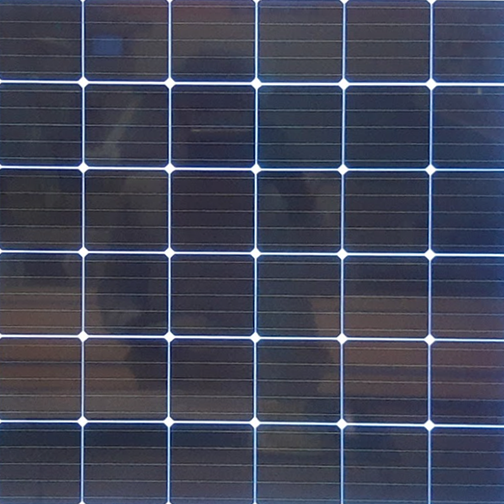
Procurement &
Construction Support
Factory Inspection
It is conducted to ensure quality of modules at multiple levels. Different levels of quality inspection include cell, glass, EVA, lamination and backsheet.
There are 3 types of services:
01. Quality management system (QMS)
Objective: To ensure the reliability of the product for the next 25 years of the life cycle.
OEM demonstrates the manufacturing consistency, process control, and traceability, conducts robust supplier audits and offers good customer support
Factory audit of module manufacturer to assess the manufacturer capability in producing a reliable product
02. Module in-production inspection
Objective: To ensure that the product is being manufactured as per the quality assurance plan, bill of materials and design specifications agreed with the manufacturer and the dispatch products are healthy
Inspection of raw material, process and finished goods of the product
Monitoring of various production parameters and validation of in-line tests to ensure top quality of modules (Sampling done as per ISO 2859-1)
03. Finished goods inspection (FGI)
Objective: To ensure that the product dispatched is healthy, without damages and as per the pre-agreed quality assurance plan
Final inspection of the finished good from the lot offered by the manufacturer as per the criteria (Sampling done as per ISO 2859-1)
Ribbon peel test
Front
Back
This is done to check the soldering strength of ribbon connected to cell busbar on both front and back side to ensure that that there is appropriate connection between them
Pre-lamination EL Imaging
Prelamination EL imaging is done to catch any defect before the lamination process, so that appropriate repair/corrective action can be taken.
Monitoring Curing conditions
Curing is a very important aspect to ensure that the pottant and sealants used are settled properly to ensure higher lifetime. So monitoring the curing environment also becomes critical
Case Study
Pre-dispatch inspection of modules
Abrasion marks and drain hole marks of frame
Module with bubble
Module with conductive dust
300 Wp (80 modules) lot rejected due to the damages observed in EL images
Observations
Multiple scratch marks and abrasion marks observed on the frames of the modules
Bubbles, solder particles, string to string gap more than 3.5 mm and label gapeless less than 1 mm observed in 200 Wp
Cleaning of EVA residue on glass and frame
Cleaning of RTV residue on backsheet
4 modules from 320 Wp lot were asked to be replaced due to micro-cracks
>5 nos of polluted cells with dark area >5%
Cells with mis-match color
Non-uniform sealant on the back of the modules
Observations
Presence of scratch on front-side glass
Bubbles in the label
Non-uniform sealant coverage on the back-side of the modules
Cells with mis-match color
Multiple modules with polluted cells with dark area>5%
Transportation Damage Assessment
Module damage risks are usually high due to mishandling and carelessness during the transportation. To assess these damages, EL Imaging and Flash tests are conducted and the results are used as a benchmark to keep/ discard the modules.
Case Study
Post shipment module inspection
Post shipment module inspection
Wafer defects and edge isolation
Plant location:Rajasthan
The client suspected that the modules were damaged during transportation
Observations
18% modules had wafer defects and edge isolation
6% modules had severe edge isolation
7% modules had micro-cracks
14% modules had partial, full, compound or point cracks
Modules were identified to be replaced by the manufacturer
Certain modules were identified to be kept under close monitoring as they could lead to hotspots which would be a reliability and safety concern.
Post-installation Quality Assessment
During installation, there are damage risks due to mis-handling of the modules. To assess this damage, EL Imaging or Flash testing can be conducted.
Case Study
Post-transportation and post-installation damage analysis of modules
Plant details: 50 MWp plant in Tamil Nadu. Study conducted for a 5 MW batch
Observations
3 modules were severely damages post-transportation and were rejected
Approx. 2.1% modules had slight contact issue, which can be taken up with the module manufacturer
23.5% corner modules were damaged in the pallet. This implies that pallets placed next to the container walls were not packed properly
Approx. 8.5% of modules had some form of cracks (partial, full, compound or point/spider crack) in post transportation study, but approx. 22% modules had cracks during post installation study
Owner’s Engineer
Quality and management of the site starts from the design phase itself. To ensure that all the documentation is technically sound, third party intervention is a smart method.
An Owner’s Engineer is responsible for following activities:
To ensure that all the designs of the plant is inline with the on-site designing
To consult on the current equipment selection
Quality control on-site at the time of installation and commissioning
To ensure that all the activities are executed within the specified timeline
To ensure that all the on-site tests are conducted as per the client’s checklist
Detailed visual inspection of the incoming materials for quality authentication
Know more about our other services
Plant Quality Assessment
To get a better understanding of the plant’s performance, several tests are conducted on-site. These tests evaluate the quality of equipment on the site and support in creating the action plan for optimising the performance. These activities also evaluate the accessibility, availability and maintenance quotation of the plant.
Technical Due Diligence
To analyze and estimate the OPEX, CAPEX and revenue generation from the solar asset under bidding, technical performance of the plant plays a crucial role. This study includes all the factors essential for understanding the technical aspects of the plant and its future revenue scope.
















